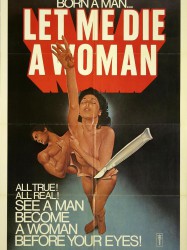Les films ayant le thème "Documentaire sur l'homosexualité", triés par recette

The Adonis Factor (2010)
Origine Etats-Unis
Genres Documentaire
Thèmes Sexualité, Homosexualité, Documentaire sur l'homosexualité, LGBT, LGBT
Acteurs Bruce Vilanch, Quentin Elias
Hines' film examines issues of body image in the gay community.

Beautiful Darling (2010)
, 1h22Origine Etats-Unis
Genres Documentaire
Thèmes Sexualité, La télévision, Homosexualité, Transsexuels et transgenres, Documentaire sur le monde des affaires, Documentaire sur le cinéma, Documentaire sur l'homosexualité, Documentaire sur une personnalité, LGBT, LGBT
Acteurs John Waters, Candy Darling, Chloë Sevigny, Andy Warhol, Fran Lebowitz, Penny Arcade

Cul de sac (2010)
, 1h38Origine Royaume-uni
Genres Documentaire
Thèmes Sexualité, Homosexualité, Documentaire sur l'homosexualité, Documentaire sur une personnalité, LGBT, LGBT, Lesbianisme

I Am (2011)
, 1h16Réalisé par Tom Shadyac
Origine Etats-Unis
Genres Documentaire
Thèmes Sexualité, Homosexualité, Documentaire sur le monde des affaires, Documentaire sur le cinéma, Documentaire sur l'homosexualité, Documentaire sur une personnalité, Documentaire autobiographique, LGBT, LGBT
Acteurs Jim Carrey, Tom Shadyac
Frôler la mort ne laisse pas indemne… Tom Shadyac - réalisateur de célèbres comédies à l’instar de Bruce tout puissant, Ace Ventura et prochainement du remake U.S. d’Intouchables - a vu sa vie bouleversée par un grave accident. Renonçant aux fastes de Hollywood, il décide de partir, caméra au poing, à la rencontre d’intellectuels et de scientifiques afin de trouver les réponses aux 2 questions qui l’obsèdent : "Qu’est-ce qui ne va pas dans le monde actuel ?" et "Que peut-on faire pour améliorer la situation ?".

Raising Hell (2010)
, 31minutesOrigine Royaume-uni
Genres Documentaire
Thèmes L'enfance, Sexualité, Homosexualité, Documentaire sur l'homosexualité, Documentaire sur une personnalité, LGBT, LGBT, Lesbianisme

Stonewall, la révolution gay (2010)
, 1h22Origine Etats-Unis
Genres Documentaire
Thèmes Sexualité, Homosexualité, Documentaire sur l'homosexualité, LGBT, LGBT
Stonewall Uprising est un film documentaire américain de 2010 examinant les événements entourant les émeutes de Stonewall qui ont commencé aux premières heures du 28 juin 1969. Stonewall Uprising a fait ses débuts en salles le 16 juin 2010 au Film Forum de New York. entretiens avec des témoins oculaires de l'incident, dont l'inspecteur adjoint du NYPD, Seymour Pine.

Too Much Pussy ! (2011)
, 1h20Réalisé par Émilie Jouvet
Origine France
Genres Comédie, Documentaire, Aventure
Thèmes Féminisme, Politique, Sexualité, Transport, Homosexualité, Documentaire sur l'homosexualité, Politique, Road movie, LGBT, LGBT, Lesbianisme
Acteurs Judy Minx
Un road-movie documentaire sur la tournée de femmes artistes queers nord-américaines et européennes, entre les discussions pendant les trajets en minibus, les haltes dans des squats à roulottes allemands et les performances burlesques et feministes pro-sexe (le « queer X show ») sur des scènes des villes européennes en été 2009.

Le ciel en bataille (2011)
, 42minutesGenres Documentaire
Thèmes Sexualité, Homosexualité, Documentaire sur le monde des affaires, Documentaire sur le cinéma, Documentaire sur l'homosexualité, Documentaire sur une personnalité, Documentaire autobiographique, LGBT, LGBT
At his dying father's bedside Rachid B. recalls his strongest memories from his childhood in Morocco to recollections of his homosexuality and rejection of Christianity, right up to his recent conversion to Islam.

Chely Wright: Wish Me Away (2011)
, 1h36Origine Etats-Unis
Genres Documentaire, Musical
Thèmes Sexualité, Homosexualité, Documentaire sur l'homosexualité, Documentaire sur une personnalité, LGBT, LGBT, Lesbianisme

Gen Silent (2011)
, 1h3Réalisé par Stu Maddux
Origine Etats-Unis
Genres Documentaire
Thèmes Sexualité, Homosexualité, Documentaire sur l'homosexualité, Documentaire sur la santé, LGBT, LGBT
Gen Silent was filmed in the Boston area over a one year period. During that time, director Stu Maddux followed six LGBT seniors through their decision to either stay open about their sexuality or hide it so that they can survive in the long-term health care system. In the documentary a gay man named Lawrence Johnson searches for a nursing home where he and his partner can be open about their relationship while still receiving quality care. It also follows a transgender senior by the name of KrysAnne. She searches for people to care for her because she is estranged from her family. The story of an LGBT couple named Sheri and Lois is told, including how they spent their lives fighting for LGBT rights. While Sheri states that she refuses to hide her sexuality, Lois states that she will if that is what it would take to protect her in the health care system. Mel and his partner are the final couple followed in the documentary. Mel’s partner gets sick and he finds care from a welcoming agency where he feels comfortable and safe to speak openly for the first time about his sexuality and their thirty-nine year relationship together.

Married in Canada (2010)
, 1hOrigine Canada
Genres Documentaire
Thèmes La famille, Sexualité, Homosexualité, Documentaire sur l'homosexualité, LGBT, Mariage homosexuel, LGBT
Married in Canada follows seven American couples, 3 gay male and 4 lesbian couples, deciding to benefit from Canadian legalized marriage laws to get married in Toronto, while they are prohibited from doing so in the United States in their resident states. The couples and their families illustrate why overcoming the obstacles to legal nuptials is worthwhile, despite the reality that once back home south of the border, the newlyweds will remain merely 'married in Canada' as their marital status will be unrecognized. The marrying couples also candidly discuss differences in attitude between Americans and Canadians based on their experiences in Canada including human rights, homophobia, openness of society and acceptance of the other. The film also takes an inside view on a Canadian agency catering for cross-border same-sex marriage packages to the United States and other countries.

Bambi : une nouvelle femme (2013)
Réalisé par Sébastien Lifshitz
Genres Documentaire
Thèmes Sexualité, Homosexualité, Transsexuels et transgenres, Documentaire sur l'homosexualité, LGBT, LGBT
Dès sa plus tendre enfance à Alger, Marie-Pierre ne veut s’habiller qu’en robe et refuse obstinément son prénom de naissance : Jean-Pierre. A 17 ans, sa vie bascule lorsqu’elle découvre la revue d’un cabaret de travestis en tournée : le Carrousel de Paris. En quelques années, elle devient « Bambi », figure mythique des cabarets parisiens des années 50-60. En recueillant le témoignage d’une des premières transsexuelles françaises, Sébastien Lifshitz poursuit le travail entamé avec « Les Invisibles » et trace le destin d’une personnalité hors du commun.

Let Me Die a Woman (1978)
, 1h19Réalisé par Doris Wishman
Origine Etats-Unis
Genres Documentaire
Thèmes Sexualité, Erotique, Sexploitation, Homosexualité, Transsexuels et transgenres, Documentaire sur l'homosexualité, LGBT, LGBT
Acteurs Vanessa del Rio
The film features interviews with sex reassignment surgeon Dr. Leo Wollman and various trans people.

Ballot Measure 9 (1995)
, 1h12Origine Etats-Unis
Genres Documentaire
Thèmes Sexualité, Homosexualité, Documentaire historique, Documentaire sur l'homosexualité, Documentaire sur la politique, Politique, LGBT, LGBT

That Man: Peter Berlin (2005)
, 1h20Origine Etats-Unis
Genres Documentaire
Thèmes Sexualité, Homosexualité, La pornographie, Documentaire sur le monde des affaires, Documentaire sur le cinéma, Documentaire sur l'homosexualité, Documentaire sur une personnalité, LGBT, LGBT
Acteurs John Waters
 Connexion
Connexion